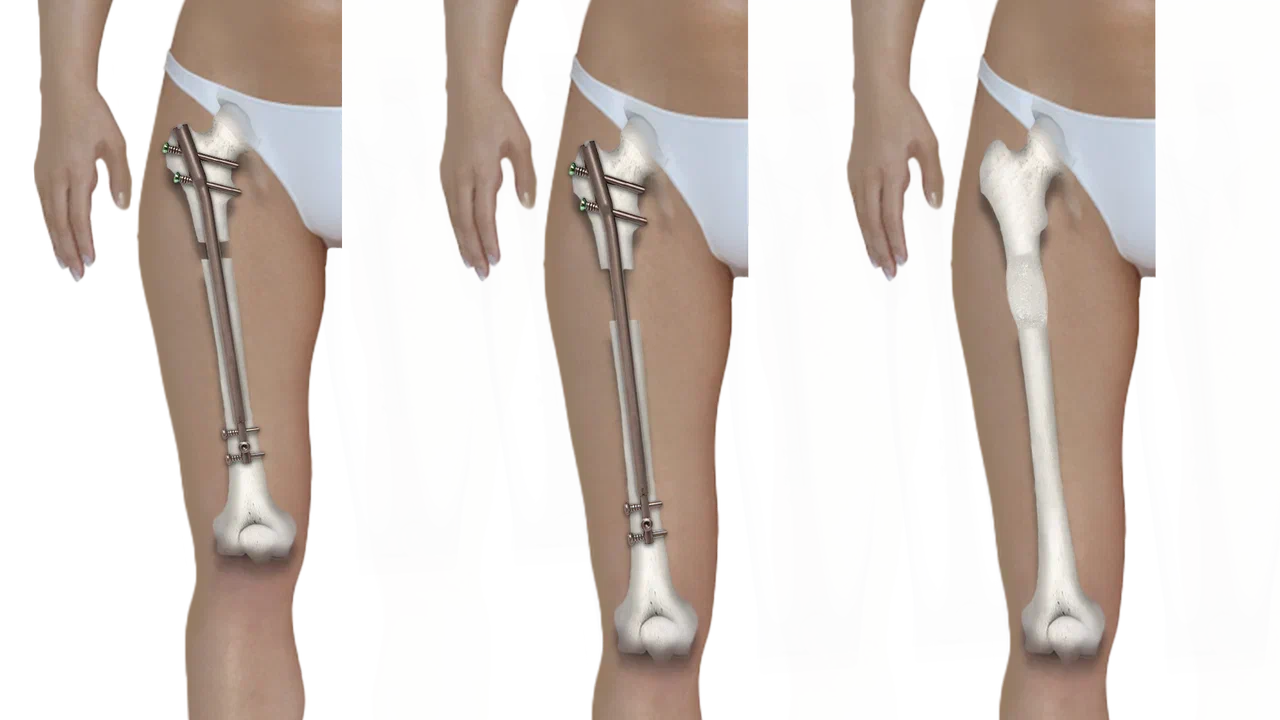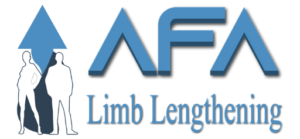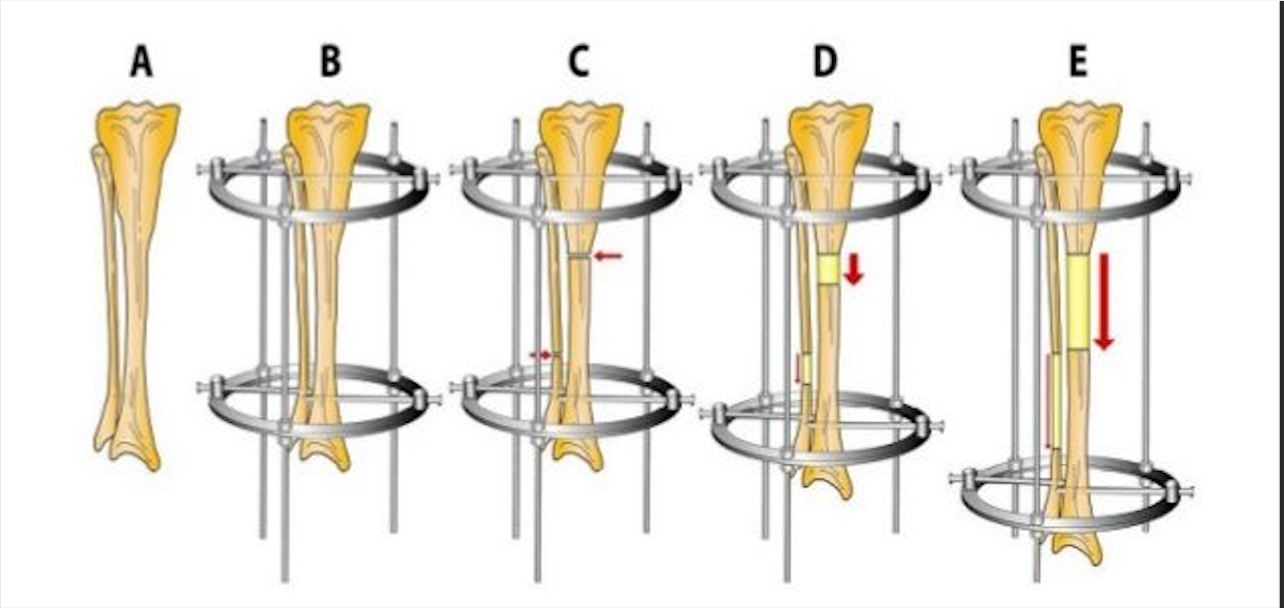What is distraction osteogenesis?

Distraction osteogenesis, also known as callus distraction or osteodistraction, is a natural process harnessed in orthopedic surgery, limb lengthening procedures, and surgeries to correct bone deformities. Essentially, it’s a method for lengthening shorter bones. The procedure entails precisely cutting the bone at a specific location and gradually pulling apart the bone ends at a controlled pace. This gradual separation creates a gap between the two bone parts, which is then filled with new bone tissue called callus or osteogenesis, resulting in the bone becoming longer and better aligned.
History of Distraction Osteogenesis
In 1905, Dr. Alessandro Codivilla introduced the concept of gradual bone lengthening by using serial casts to extend a femur. Subsequently, in 1927, Dr. Abbot replaced the casts with large pins inserted through fractured femur segments and utilized springs to facilitate limb lengthening. These early methods, although pioneering, were fraught with complications. Infections, ischemic necrosis of skin and muscle, malunion (improper bone healing), and delayed ossification with fibrous union were common problems associated with these procedures.
The concept of distraction osteogenesis saw a resurgence in the 1950s, thanks to the pioneering work of Dr. Gavril Ilizarov. He refined the technique by performing a corticotomy, a controlled bone cut that minimally disrupted the surrounding blood supply, and introduced a system of tension ring fixators. These fixators provided precise control over the rate and direction of bone distraction, minimizing complications.
Dr. Ilizarov’s experimental studies and clinical applications laid the foundation for distraction osteogenesis and its role in orthopedic management. It wasn’t until 1973 that its applications in craniofacial surgery began to emerge, when Dr. Synder and colleagues used the approach for mandibular lengthening in a canine animal model. It took almost two more decades for the technique to be applied to human craniofacial surgery, with Dr. McCarthy and colleagues publishing the first report of mandibular lengthening in children with congenital mandibular deficiency and related conditions in 1992. Subsequently, its application expanded to various craniofacial reconstruction procedures, making it a valuable tool in the field.
In summary, distraction osteogenesis has a history that spans over a century, from early and problematic attempts at bone lengthening to its revival and refinement by Dr. Ilizarov in the mid-20th century. This technique has evolved into a vital part of orthopedic and craniofacial surgery, offering improved outcomes with reduced complications for patients with limb length discrepancies and skeletal deformities.
How Does Distraction Osteogenesis Works ?
1.Osteotomy:
The process starts with a surgical procedure known as an osteotomy. During this operation, the orthopedic surgeon makes a precise cut in the bone that needs to be lengthened.
2. Bone Segment Stabilization:
Bone segment stabilization techniques in limb lengthening involve the use of internal, external, and combined methods to ensure stability and promote successful outcomes:
External Fixation:
Description: External fixators are devices placed outside the body, typically consisting of pins or wires inserted into the bone and connected to an external frame.
Function: They provide stability during lengthening by controlling the movement of bone segments externaly.
Examples: Ilizarov, circular or monorail fixators.
Internal Fixation:
Description: Intramedullary devices, such as nails or rods, are inserted inside the bone to offer internal support and stability.
Function: Internal fixation reduces the need for external hardware and supports the bone from within.
Examples: PRECICE Intramedullary Nail.
Combined Fixation:
Description: This technique involves using both internal and external fixation methods simultaneously.
Function: By combining the benefits of internal and external stabilization, it aims to enhance overall stability and control.
Example: LON (Lengthening over nail) Method
These stabilization techniques are chosen based on factors like the patient’s condition, deformity level, specific bone involved, patient preference and the goals of the lengthening procedure.
3. Latency Period:
The latency period is a crucial phase in distraction osteogenesis. It begins right after the osteotomy, creating a sort of “rest” period following the bone-cutting procedure. During this time, various biological responses take place. Fibroblast proliferation increases, and periosteal reactivity is induced, much like the early stages of bone fracture healing. This latency period allows for the organization of the hematoma and the formation of a fibrous tissue matrix. This matrix acts as a scaffold for the proliferation of osteoblasts, which in the first 24 hours generate osteoid on the bone surfaces. Additionally, this phase promotes periosteal and endosteal revascularization. Latency period duration varies between 5-10 days depending on the patient’s condition.After it is seen that callus organization has started in the patient, lengthening is started.
4. Distraction (Lengthening) Period:
During the distraction period of bone lengthening procedure, the patient need to adjust a specialized orthopedic device every day. This device slowly pulls the two bone segments apart at a rate of about 1 mm (0.04 inches) per day. However, this rate can vary a bit depending on the bone being extended. For example, in the tibia, the daily distraction might be 0.75 mm, but in the femur or humerus, it could be 1.0 mm.
This gradual pulling apart stimulates the body to continuously grow new bone. This distraction phase keeps going until the bone reaches the desired length.
During the distraction period of the distraction osteogenesis process, several important things happen:
- Bone Growth: Tension forces are applied to the separated bone segments, which makes the bone grow. This growth can be surprisingly fast, much faster than normal bone growth.
- X-ray Changes: If you take X-rays during this time, you can see changes in the bone. Collagen, a protein in your body, is deposited as the bone forms.
- Special Zone: In the middle of the new bone area, there’s a special zone called the fibrous interzone. This area has cells that help with bone formation.
- Micro-Columns: Bone tissue is created in structures called micro-columns. They look a bit like stalactites and stalagmites you might see in a cave. These structures form along collagen fibers.
- Bone Formation: New bone is mainly formed directly from tissue without going through a cartilage stage.
- Blood Vessels: During this process, many new blood vessels form around the growing bone.
- Mechanical Changes: The mechanical forces applied to the bone not only make it grow but also change the behavior of cells in the area.
- Regular Check-Ups: Surgeon will need to keep checking your progress with X-rays to make sure everything is going as planned.
When the bone reaches the desired length, the distraction stops, and the bone is allowed to harden and mature.
5: Consolidation Period:
During this phase, the regenerated bone starts to solidify, forming a dense central region. Over several weeks, the regenerated tissue transforms into a more organized bone structure.Columns of regenerated tissue become homogeneous, resembling primary bone tissue, and longitudinal trabeculae transform into transverse plaques. Bone micro-columns, covered with osteoblasts, actively produce osteoid. This phase involves continuous recruitment and activation of cells, exceeding typical fracture healing processes. Remodeling results in porosis of the bone cortex, and Havers channels, facilitating blood vessels and nerves, form after 4–6 months in humans.The consolidation time varies depending on factors like weight-bearing and angular adjustments. Complete bone remodeling occurs in 12–24 months. Radiographs are practical for assessing consolidation efficiency.Various diagnostic methods, including radiography, tomography, scintigraphy, and ultrasound, can be used to assess the consolidation efficiency. Radiographs are often a practical method for determining when the bone is ready for the removal of the external or internal fixation system.
Complications in Distraction Osteogenesis
Distraction osteogenesis (DO) can lead to various complications, including muscular contractures, subluxations, vascular and nerve damage, premature or delayed consolidation, and bone non-union.
- Premature consolidations: Premature consolidation may occur in patients with high bone healing rate. The complication can be prevented by increasing the lengthening rate.
- Delayed consolidations: Delayed Consolidation usually happens in patients with a low bone healing rate. Late union is also quite common in patients with high lengthening rates. Regular X-rays should be followed well and new callus formation should be monitored to determine the lengthening rate.
- Bone non-union: The risk of bone non union is very low as long as the lengthening period process is managed professionally. Poor genetic bone healing rate, osteomyelitis, severe alignment disorders , lack of bone ends stabilization and high lengthening rate increase the risk of non union. Strict radiographic monitoring helps detect and address these complications early on.
- Neuromuscular Complications: Neuromuscular complications are rare unless the lengthening exceeds 20% of the orijinal bone length. The risk of nerve injury is very serious and immediate action must be taken. The risk of nerve damage increases in cases where the lengthening rate exceeds 1 mm. Nerve damage symptoms must be monitored regularly and the lengthening speed should be adjusted.
- Muscle Contracture: There may be increased muscle tension and a decrease in normal ROM during lengthening, but severe muscle tension and decreased joint motion may delay return to normal physical capacity after the end of lengthening. Physical therapy is very effective in reducing muscle contractures. Muscle tension can be kept at a normal level with intensive physical therapy program.


